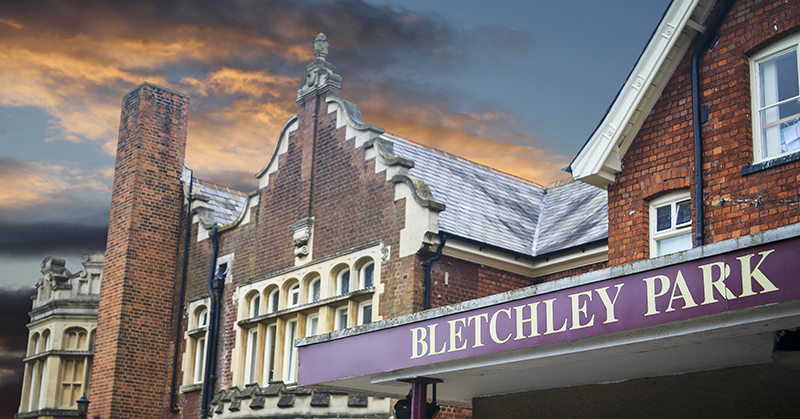Grim’s Dyke has an expansive history and is one of the most notably active sites in Harrow. Not only does it have a connection that goes back to the first years of the very first century, it’s also an important site of historical interest, due to the Anglo-Saxon earthworks known as Grim’s Ditch, its rich architectural connections to the architect Norma Shaw and of course, it is the prior home of foremost English dramatist, Sir W.S. Gilbert. But what isn’t so obvious, is its important historical links to Bletchley Park and World War II.
Grims Dyke and its Bletchley Park connections
Like many large estates of the time, Grim’s Dyke was used for secret military work during World War II. Although many of the details are still classified until the 2040s, it’s believed Grim’s Dyke was used to examine captured German machinery and parts of shot down aircraft – parts analysed by Allied scientists from Bletchley Park.
It is thought the secret work carried out at Grim’s Dyke was so important to the war effort, both Winston Churchill and General Eisenhower visited the house.
Bletchley Park
The site Bletchley Park now stands on was part of the Manor of Eaton. A mansion was built on the site in 1711 but was pulled down in 1793. It first became known as Bletchley Park in 1877, when Samuel Lipscomb Seckham purchased it. The existing nineteenth-century mansion was built on the site of those older buildings, when Sir Herbert Samuel Leon, a financier and politician bought the land from Seckham in 1883.
Bletchley Park came to prominence in 1938, as a code-breaking centre. It was the central site for British and Allied codebreakers during World war II. Housing the British Government Code and Cypher School (GC&CS) Bletchley was responsible for producing ‘Ultra’ intelligence – intelligence that is believed to have both shortened the war by two to four years and shape its outcome.
Admiral Sir Hugh Sinclair
The mansion and much of the site was bought by a builder in 1938, who was planning to build a housing estate on the land. However, in May that same year, Admiral Sir Hugh Sinclair, head of the Secret Intelligence Service (SIS or MI6) used his own money to buy the site. He thought it was ideally located, immediately adjacent to Bletchley railway station and where the Varsity Line between Oxford and Cambridge met the main West Coast railway line. The main road that linked London to the north-west was also close by – as was the nearby Fenny Stratford telegraph and telephone repeater station.
World War II and the codebreakers
On 15 August 1939, the first personnel of the GC&CS moved in. The Navy, Military, and Air SEctions were located in the mansion, which also housed a telephone exchange, teleprinter room, kitchen and dining room. The Top floor was allocated to MI6. Later that year wooden huts began to be constructed in the grounds and the neighbouring boys boarding school – Elmers School, was acquired for the Commercial and Diplomatic Sections.
The team at Bletchley Park created Colossus, the world’s first programmable digital electronic computer. The team of codebreakers included notable personalities such as Alan Turing, Gordon Welchman, Hugh Alexander and Stuart Milner-Barry. They were responsible for breaking secret communications created with the Germans Enigma and Lorenz cypher machines – machines that were considered unbreakable. However, due to flaws in German cryptographic procedures and poor discipline among the personnel, the team at Bletchley were able to break the codes.
At its peak, GC&CS were reading approximately 4,000 messages per day.
Post World War II
Codebreaking operations at Bletchley Park ceased in 1946 and remained classified until the mid-1970s. After the war, the GC&CS became known as the Government Communications Headquarters (GVHQ). However, in 1946, they moved to another site in Eastcote. The site was then used by various agencies, before the General Post Office (GPO) took over the site until 1990, using it as a management school.
In 1987 block F, a large building originally housing the Newmanry and Testery sections of Bletchley Park’s codebreaking team, along with the Japanese Military Air Section, was demolished and the site was being run down.
The Bletchley Park Trust was formed in 1991, to save this historic site from developers and Milton Keynes Borough Council declared most of the Park a conservation area in February 1992. A museum was opened here in 1993 and visitors were allowed to visit the site. It was formally inaugurated by its Chief Patron, HRH The Duke of Kent in July 1994 and, in 1999 the landowners granted the Trust a lease, handing them control over most of the site. A subsequent restoration project was completed in June 2014, following funding from Heritage Lottery Fund, Google and funds raised by the Bletchley Park Trust.
As the majority of work carried out at both Bletchley Park and Grim’s Dyke are classified until the mid 2040s, it’s a delight to have this brief history available to us. It’ll be fascinating though, to see how much of an impact these two places had on the overall war effort, once those classifications are removed!


